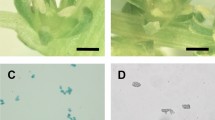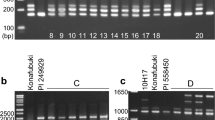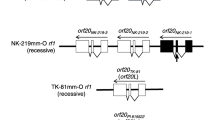Abstract
I-12CMS(2) and I-12CMS(3) are sugar beet lines with different sources of cytoplasmic male sterility (CMS) derived from wild beets in Turkey and Pakistan, respectively. We established that I-12CMS(2) has a genetically distinct cytoplasm, but its mitochondrial genome is very similar to I-12CMS(3). Male fertility was assessed in F1 hybrids produced with a common pollen parent. Fertility in the F1's carrying the I-12CMS(3) cytoplasm exceeded that of the F1's with the I-12CMS(2) cytoplasm. Organization of the I-12CMS(2) and I-12CMS(3) mitochondrial genomes were compared based on their physical maps. Mitochondrial genomes of the two strains were largely collinear, except for a large deletion in the noncoding region of I-12CMS(2). Because a mitochondrial orf129 in the I-12CMS(3) cytoplasm is associated with a male sterility phenotype and preservation of orf129 was evident in I-12CMS(2), I-12CMS(2) orf129 was investigated in detail. I-12CMS(2) plants contained three to five times more ORF129 protein than did I-12CMS(3) plants. A single nucleotide substitution, present in the putative promoter region of orf129, appeared to be responsible for the differential accumulation of orf129 transcript. A long N-terminal extension of atp6 is a common feature of some beet CMSs and is found in I-12CMS(2), but the amino acid sequence is unique. I-12CMS(3) mitochondria, but not I-12CMS(2) mitochondria, were found to be heteroplasmic. This heteroplasmy is characterized by a substoichiometric DNA molecule(s) that has at least two I-12CMS(2)-type mitochondrial loci, suggesting the possibility that the I-12CMS(2) mitochondrial genome might have evolved from such a substoichiometric DNA molecule in I-12CMS(3) mitochondria.









Similar content being viewed by others
References
Allen JO, Fauron CM, Minx P, Roark L, Oddiraju S et al (2007) Comparisons among two fertile and three male-sterile mitochondrial genomes of maize. Genetics 177:1173–1192
Bosemark NO (1979) Genetic poverty of the sugarbeet in Europe. In: Zeven AC & Van Harten AM (Eds.). Proceedings of Conference Broadening Genet Base Crops, Wageningen, The Netherlands. Pudoc Wageningen, pp 29–35
Bosemark NO (2006) Genetics and breeding. In: Draycott AP (ed) Sugar beet. Blackwell Publishing, Oxford, pp 50–88
Budar F, Touzet P, Pelletier G (2006) Cytoplasmic male sterility. In: Ainsworth C (ed) Flowering and its manipulation. Blackwell, Oxford, pp 147–180
Chen L, Liu Y-G (2014) Male sterility and fertility restoration in crops. Annu Rev Plant Biol 65:579–606
Cheng D, Kitazaki K, Xu D, Mikami T, Kubo T (2009) The distribution of normal and male-sterile cytoplasms in Chinese sugar-beet germplasm. Euphytica 165:345–351
Cheng D, Yoshida Y, Kitazaki K, Negoro S, Takahashi H et al (2011) Mitochondrial genome diversity in Beta vulgaris L. ssp. vulgaris (Leaf and Garden Beet Groups) and its implications concerning the dissemination of the crop. Genet Res Crop Evol 58:553–560
Christensen CA (2014) Genes and junk in plant mitochondria–repair mechanisms and selection. Genome Biol Evol 6:1448–1453
Darracq A, Varre JS, Marechal-Drouard L, Courseaux A, Castric V et al (2011) Structural and content diversity of mitochondrial genome in beet: a comparative genomic analysis. Genome Biol Evol 3:723–736
Dohm JC, Minoche AE, Holtgrawe D, Capella-Gutierrez S, Zakrzewski F et al (2014) The genome of the recently domesticated crop plant sugar beet (Beta vulgaris). Nature 505:546–549
Doyle JJ, Doyle JL (1990) Isolation of plant DNA from fresh tissue. Focus 12:13–15
Duvick DN (1965) Cytoplasmic pollen sterility in corn. Adv Genet 13:1–56
Fenart S, Touzet P, Armaud J-F, Cuguen J (2006) Emergence of gynodioecy in wild beet (Beta vulgaris maritima L.): a genealogical approach using chloroplastic nucleotide sequences. Proc R Soc London B 273:1391–1398
Fujii S, Kazama T, Yamada M, Toriyama K (2010) Discovery of global genomic re-organization based on comparison of two newly sequenced rice mitochondrial genomes with cytoplasmic male sterility-related genes. BMC Genomics 11:209
Gagliardi D, Binder S (2007) Expression of the plant mitochondrial genome. In: Logan DC (ed) Plant mitochondria. Blackwell, Oxford, pp 50–96
Hagihara E, Itchoda N, Habu Y, Iida S, Mikami T et al (2005) Molecular map** of a fertility restorer gene for Owen cytoplasmic male sterility in sugar beet. Theor Appl Genet 111:250–255
Hallden C, Lind C, Moller IM (1992) Variation in mitochondrial translation products in fertile and cytoplasmic male-sterile sugar beets. Theor Appl Genet 85:139–145
Hanson MR, Bentolila S (2004) Interactions of mitochondrial and nuclear genes that affect male gametophyte development. Plant Cell 16:S154–S169
Itabashi E, Kazama T, Toriyama K (2009) Characterization of cytoplasmic male sterility of rice with Lead Rice cytoplasm in comparison with that with Chinsurah Boro II cytoplasm. Plant Cell Rep 28:233–239
Janska H, Sarria R, Woloszynska M, Arrieta-Montiel M, Mackenzie SA (1998) Stoichiometric shifts in the common bean mitochondrial genome leading to male sterility and spontaneous reversion to fertility. Plant Cell 10:1163–1180
Kawanishi Y, Shinada H, Matsunaga M, Masaki Y, Mikami T et al (2010) A new source of cytoplasmic male sterility found in wild beet and its relationship to other CMS types. Genome 53:251–256
Kubo T, Newton KJ (2008) Angiosperm mitochondrial genomes and mutations. Mitochondrion 8:5–14
Kubo T, Satoh Y, Muro T, Kinoshita T, Mikami T (1995) Physical and gene organization of mitochondrial DNA from the fertile cytoplasm of sugarbeet (Beta vulgaris L.). Curr Genet 28:235–241
Kubo T, Nishizawa S, Sugawara A, Itchoda N, Estiati A et al (2000) The complete nucleotide sequence of the mitochondrial genome of sugar beet (Beta vulgaris L.) reveals a novel gene for tRNACys(GCA). Nucleic Acids Res 28:2571–2576
Kubo T, Kitazaki K, Matsunaga M, Kagami H, Mikami T (2011) Male sterility-inducing mitochondrial genomes: how do they differ? Crit Rev Plant Sci 30:378–400
Kuhn J, Binder S (2002) RT-PCR analysis of 5′ and 3′-end-ligated mRNAs identifies the extremities of cox2 transcripts in pea mitochondria. Nucleic Acids Res 30:439–446
Lange H, Sement FM, Canaday J, Gagliardi D (2009) Polyadenylation-assisted RNA degradation processes in plants. Trends Plant Sci 14:497–504
Laser KD, Lersten NR (1972) Anatomy and cytology of microsporogenesis in cytoplasmic male sterile angiosperms. Bot Rev 3:425–454
Laughnan JR, Gabay-Laughnan S (1983) Cytoplasmic male sterility in maize. Ann Rev Genet 17:27–48
Levings CS III (1993) Thoughts on cytoplasmic male sterility in cms-T maize. Plant Cell 5:1285–1290
L’Homme Y, Stahl RJ, Li X-Q, Hameed A, Brown GG (1997) Brassica nap cytoplasmic male sterility is associated with expression of a mtDNA region containing a chimeric gene similar to the pol CMS-associated orf224 gene. Curr Genet 31:325–335
Matsunaga M, Nagano H, Mikami T, Kubo T (2011) Large 3′ UTR of sugar beet rps3 is truncated in cytoplasmic male-sterile mitochondria. Plant Cell Rep 30:231–238
Mikami T, Kishima Y, Sugiura M, Kinoshita T (1985) Organelle genome diversity in sugar-beet with normal and different sources of male sterile cytoplasms. Theor Appl Genet 71:166–171
Moritani M, Taguchi K, Kitazaki K, Matsuhira H, Katsuyama K et al (2013) Identification of the predominant nonrestoring allele for Owen-type cytoplasmic male sterility in sugar beet (Beta vulgaris L.): development of molecular markers for the maintainer genotype. Mol Breed 32:91–100
Muller K, Storchova H (2013) Transcription of atp1 is influenced by both genomic configuration and nuclear background in the highly rearranged mitochondrial genomes of Silene vulgaris. Plant Mol Biol 81:495–505
Nishizawa S, Mikami T, Kubo T (2007) Mitochondrial DNA phylogeny of cultivated and wild beets: relationships among cytoplasmic male-sterility-inducing and nonsterilizing cytoplasms. Genetics 177:1703–1712
Onodera Y, Yamamoto MP, Kubo T, Mikami T (1999) Heterogeneity of the atp6 presequences in normal and different sources of male-sterile cytoplasms of sugar beet. J Plant Physiol 155:656–660
Owen FV (1942) Male sterility in sugar beets produced by complementary effects of cytoplasmic and mendelian inheritance. Am J Bot 29:692
Sambrook J, Fritsch EF, Maniatis T (1989) Molecular cloning: a laboratory manual, 2nd edn. Cold Spring Harbor Laboratory Press, New York
Schnable PS, Wise RP (1998) The molecular basis of cytoplasmic male sterility and fertility restoration. Trends Plant Sci 3:175–180
Small ID, Isaac PG, Leaver CJ (1987) Stoichiometric differences in DNA molecules containing the atpA gene suggest mechanisms for the generation of mitochondrial genome diversity in maize. EMBO J 6:865–869
Touzet P (2012) Mitochondrial genome evolution and gynodioecy. In: Marechal-Drouard L (ed) Mitochondrial genome evolution. Academic Press, Oxford, pp 71–98
Yamamoto MP, Kubo T, Mikami T (2005) The 5′-leader sequence of sugar beet mitochondrial atp6 encodes a novel polypeptide that is characteristic of Owen cytoplasmic male sterility. Mol Genet Genomics 273:342–349
Yamamoto MP, Shinada H, Onodera Y, Komaki C, Mikami T et al (2008) A male sterility-associated mitochondrial protein in wild beets causes pollen disruption in transgenic plants. Plant J 54:1027–1036
Acknowledgments
Part of this work was conducted at the Center for Genome Dynamics, Faculty of Science, Hokkaido University. This work was supported in part by JSPS KAKENHI Grant Number 25292001.
Conflict of interest
The authors declare that they have no conflict of interest.
Author information
Authors and Affiliations
Corresponding author
Electronic supplementary material
Below is the link to the electronic supplementary material.
Rights and permissions
About this article
Cite this article
Onodera, Y., Arakawa, T., Yui-Kurino, R. et al. Two male sterility-inducing cytoplasms of beet (Beta vulgaris) are genetically distinct but have closely related mitochondrial genomes: implication of a substoichiometric mitochondrial DNA molecule in their evolution. Euphytica 206, 365–379 (2015). https://doi.org/10.1007/s10681-015-1484-2
Received:
Accepted:
Published:
Issue Date:
DOI: https://doi.org/10.1007/s10681-015-1484-2




